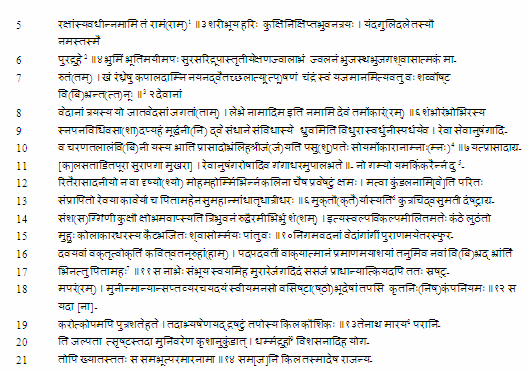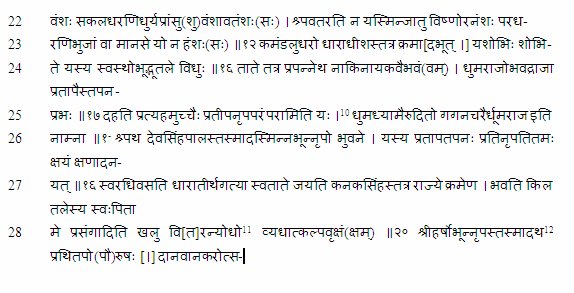| |
North
Indian Inscriptions |
| |
|
|
|
INSCRIPTIONS OF THE PARAMARAS OF MALWA
MĀNDHĀTĀ COPPER-PLATE INSCRIPTION OF THE TIME JAYAVARMAN

Second Plate : First Side

_________________________________________________________________
[1] Obeisance to Dharma and the deities, as it appears first in the Māndhātā grant of Dēvapāla (No. 51 ).
[2] Here is a reference to the legend which states that Vishṇu became the arrow with which Śiva killed the demon Tripura. See Saura-Purāṇa, 35, 16 ; and Śiva-Purāṇa(Jñāna-Saṁhitā) as pointed out by Dr. Sircar. Also see Mbh., Drōṇa Parva, Adhyāya 202, vv. 71-78 (Chitraśālā Press edn.). This idea occurs also in No. 29, v. 3, above, and also in the Śivamahimnastōtra, v. 18.
[3]
This is a beautiful description of ashṭamūrti-Śiva, reminding us of the first stanza of Kālidāsa’s Abhi- jñāna-Śākuntala.
[4] Sircar corrects this akshara to –mnā ; but as an adjective of paśupatēḥ, it should be in the sixth case. It may also be stated here that Ōṁkāra is the name of the deity and Māndhātā of the place.
[5] The akshara ri which was first engraved here was erased later on as it was repeated by mistake at the
beginning of the next line ; but the sign of the original is still visible.
[ 6] Originally क्तौ was engraved and then corrected, but the vertical which has been erased is still visible.Vishṇu. See Mark. Purāṇa (Bibliotheca Ind. edn.), Canto LXXXI.
[7] While composing this verse the poet had in his mind the description of the goddess Sarasvatī as in the Naishadhīya-Charita of Śrīharsha, X, 73 ff.
[8] Originally va, later on corrected to ya.
[9] The sign for medial ā was first attached to the letter rmma, and was subsequently scored off by two horizontal strokes.
[10] This daṇḍa was subsequently engraved just above the line where it is required, and the preceding sign of visarga was also inserted later on. Similar cases, which are found below on the plate, are not noted separately.
[11] The letter in the brackets was first engraved as va and was corrected subsequently.
[12] A redundant र was originally engraved before र्षो and was scored off by two horizontal strokes later on.
|
\D7
![]()
|









